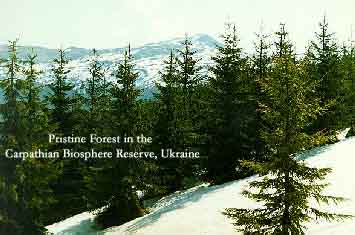
Europe was once covered
by forest, from the Arctic Ocean to the Mediterranean Sea. The original forest
covered probably 80-90% of the continent. The Gulf Stream and the North Atlantic
Stream warm the continent. The mountain chains lie mainly in east-west orientation,
so they let the westerly wind carry the rain from the ocean to the East. The
southern part of Europe has Mediterranean climate. There are more or less
severe summer droughts in this region.
"Over half of Europe's original forest cover has disappeared. On average, the forest cover is 1/3 of the total land area." Ireland has the smallest forest area (8%), Finland the largest (72%).
During recent
times, deforestation has been stopped and in a sense Europe became greener
through plantation of trees. The problem is, that in many cases conifers
have been preferred over original deciduous trees. " The plantations
and monocultures, which now cover vast tracks of land usually, offer very
poor habitats for European forest dwelling species."
The degree of naturalness
Natural /
Pristine forests:
" Following the last Ice Age, natural or pristine forests developed freely
without human intervention. These forests should show no or almost no sign
of human intervention. Old growth and even younger stages of natural forests
have a considerable amount of dead wood in the form of snags, stumps and logs.
Natural forests usually have a varied age structure; they are a rich mosaic
of trees and patches of forests of different ages. Old growth natural forests
typically contain trees which are several hundred years old."
With the new data
from the WWF forest scorecards, Taiga Rescue Network and the UN/ECE/FAO assessment
of the temperate and boreal forests , WWF could estimate for the first time
the amount of pristine or near pristine forests in Europe. " These still
cover a heartening 15-20 million hectares - nearly as much as the entire forest
area of Finland and Sweden...There is still a chance to save some outstanding
remnants of our European forest heritage."
The most of these pristine forests are located in the North, in the taiga (Komi Republic, between the White Sea and the Urals). There are patches across the Russian-Finnish border and between Norway and Sweden.
Relic
forests
Many Mediterranean and Eastern European forest types constitute relic
forests, included in the red list of plants. These are usually only several
thousands of hectares in size.
Semi-natural forests
Plantation Forests
Many of them consist of European tree species, but show clearly that they
have been planted.
Summary
The amount of pristine forests in Western Europe is just 2-3%.In the European part of Russia 5-10% of the forests can be classified as pristine or near-pristine natural forests. "Of these areas, perhaps less than 50% of pristine forests is considered to be effectively protected. The remaining unprotected old-growth and relic forests must be the priority areas for adding to the existing protected area networks in Europe. These forests represent the last vestiges of the forests which once covered Europe before the arrival of man"
